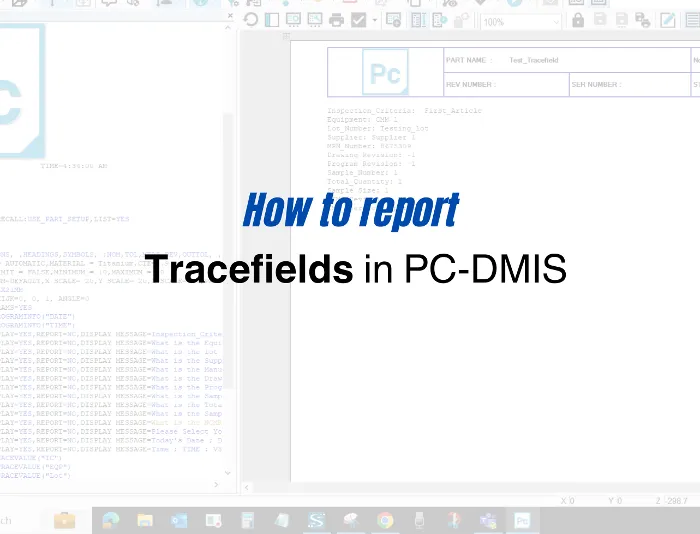How to Report a Tracefield in PC-DMIS

-
How to Report a Tracefield in PC-DMIS
-
- Introduction
- How to report a Tracefield in PC-DMIS
- Step 1: Open a Program
- Step 2: Insert the Three Tracefields
- Step 3: Create an Assignment
- Step 4: Insert the Tracefields in the Report
- Step 5: Test the Code
- Conclusion
Disclosure: Some of the links in this article may be affiliate links, which can provide compensation to me at no cost to you if you decide to purchase. This site is not intended to provide financial advice and is for entertainment only.
How to Report a Tracefield in PC-DMIS
Introduction
PC-DMIS is a software package that is used to control coordinate measuring machines (CMMs). Tracefields are an important feature of PC-DMIS that allow you to send additional information into your statistical database along with your measurement results.
How to report a Tracefield in PC-DMIS
Tracefields are used to store additional information about a measurement. They can be used to store information such as the date and time of the measurement, the operator who performed the measurement, and the part number being measured. Tracefields can be used to store any information that you want to associate with a measurement.
In this step-by-step instruction, we will report three different trace fields in our report. The three fields are Part Number, Lot Number, and Operator. You can also use the same steps to add any additional trace fields that may be required for your report.
Step 1: Open a Program
Start by opening a measurement routine that you want the traceability (tracefields) captured. If you don’t have one, create a new blank routine.
Step 2: Insert the Three Tracefields
Insert a Tracefield for the Part Number. To do this, click Insert, then Statistics Command, and then Tracefield. Under Name, type PARTNUMBER. Under Display message, type What is the Part Number. Make sure Display is checked and Report is not checked. Then, click OK.
Repeat the same steps for Lot Number. Click Insert, then Statistics Command, and then Tracefield. Under Name, type LOTNUMBER. Under Display message, type What is the Lot Number? Again, make sure Display is checked and Report is not checked. Then, click OK.
For the last Tracefield, click Insert, then Statistics Command, and then Tracefield. Under Name, type OPERATOR. Under Display message, type Operator Name. In the New value area, type your name. This time, click the Add button and add an additional name. This will display a drop-down box for the operator to choose from. Click on the Preview button. You can see that there is now a dropdown menu for the operator with multiple names. Again, make sure Display is checked and Report is not checked.
How the code should look in Command Mode
Step 3: Create an Assignment
Now we need to create an Assignment. This will allow us to create a variable for each tracefield.
Go back to Insert and click Assignment.
Change the Assign To to PART or any variable not already used in your routine.
Click on the Assign From Tab.
Make sure Functions and Operators is selected in the Dropdown.
Look for GETTRACEVALUE() and select it.
Delete the 0, click the Add[GETTRACEVALUE()] button to insert the code.
In between the parentheses, type “PARTNUMBER” Make sure you type the quotation marks or this will not work.
Click OK.
Repeat the same steps for the Lot Number and Operator Name.
How the code should look in Command Mode
Step 4: Insert the Tracefields in the Report
There is only one last step before we test it.
Start typing Comment. The word Comment will autofill.
Hit Tab and start typing Rept. Again, Rept will autofill.
Hit Tab twice to bring your cursor to the first line of the comment box.
Hit the Space bar and hit Enter.
In quotation, type “Part Number: (spacebar twice)” end quote.
Hit the space bar twice again.
Type +PART.
Hit Enter to start the next comment line.
In quotation, type “Lot Number: (spacebar twice)” end quote.
Hit the space bar twice again.
Type +LOT.
Hit Enter to start the next comment line.
In quotation, type “Operator: (spacebar twice)” end quote.
Hit the space bar twice again.
Type +NAME.
Hit Enter to start the next comment line.
This is how the code should look in Command Mode.
Step 5: Test the Code
In order to test if the code works properly, highlight the Tracefields, Assignments, and Comments. Click CTRL L. Fill in the three fields accordingly, and click OK. Refresh the report. If you see the three fields in the report, the code is correct. If not, review that the code is entered properly, refresh the report again, and see if it worked.
Make your life easy and purchase the script to import easily into your measurement Routine!!!
Conclusion
In conclusion, tracefields are an important feature of PC-DMIS that allow you to store additional information about a measurement. By using tracefields, you can send additional information into your statistical database along with your measurement results. We hope that these step-by-step instructions have been helpful.
Related Article: How to Report Elapsed Run Time in PC-DMIS
Related Article: How to Import Basic Script for Tracefields in PC-DMIS
Related Article: How to Import Basic Script for Elapsed Run Time in PC-DMIS
-
How to Report a Tracefield in PC-DMIS
-
- Introduction
- How to report a Tracefield in PC-DMIS
- Step 1: Open a Program
- Step 2: Insert the Three Tracefields
- Step 3: Create an Assignment
- Step 4: Insert the Tracefields in the Report
- Step 5: Test the Code
- Conclusion
Disclosure: Some of the links in this article may be affiliate links, which can provide compensation to me at no cost to you if you decide to purchase. This site is not intended to provide financial advice and is for entertainment only.











